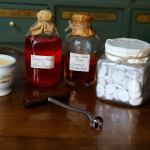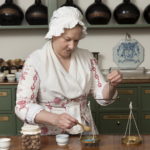It’s that time of year. Coworkers are out sick, kids are missing school, and friends are posting on social media about all the nasty stomach bugs going around. In addition to over-the-counter solutions, many of you may be turning to all-natural remedies, including essential oils. But what would they have used in the 18th century?
“Influenza” was a word in use by the late 1700s but it was more commonly called the “contagious catarrh.” Robin Kipps and Sharon Cotner from the Apothecary explained oils were not in use then because there was plenty of fresh material readily available.” Today it is harder for some people to get access to such material which contributes to the contemporary use of essential oils,” Robin explains.
Many of you may use your oils in vaporizers especially to treat congestion. Interestingly, research from the period does show advice for breathing steam. Specifically, one treatment required you to pour boiling water over rosemary leaves and then inhale the steam.
Here are other ways colonists would have treated their symptoms.
TREATING COLD SYMPTOMS IN THE 18TH CENTURY
Fever: Peruvian Bark and Willow Bark were used to treat fevers. There were experiments taking place in the 18th century using thermometers to test a possible correlation between temperature and fever. But most doctors checked for an elevated pulse and warm skin to make their diagnosis.
Cough: Licorice (made into lozenges) and hot chocolate (made with spices) were both used as cough suppressants. Garlic syrup was also used as an expectorant to help break up “phlegms of the chest.” Today, we know garlic has a bonus benefit in that it acts as a weak antibiotic.
Hoarseness: Syrup of Marshmallow Roots was the way to go if all that coughing made your voice raspy. Also called “Althea,” the root is still used in modern medicines to help treat coughs.
Sore Throat: Honey, lemon, and sugar candy (equal parts) were mixed together and eaten to soothe the pain of a sore throat.
Runny Nose: Lozenges of Sulfur were prescribed to help get your sniffles under control.
Upset Stomach: Mint was mashed with sugar into a paste and was used as a way to treat nausea.
There’s also evidence in both domestic and professional books from the 18th century that elderberry was used to treat colds. Modern science, of course, shows this botanical has some anti-viral properties.
In addition to these prescriptions, the doctor would also try to regulate the patient’s activities. It’s a regimen physicians still recommend to this day! Resting, staying in a warm bed, and eating foods that are easily digestible. The best suggestion? Chicken soup! It turns out, chicken soup has been the go-to remedy from as far back as the 12th century.
Again, a special thank you to Robin and Sharon for taking time out of their winter training in the Historic Area to help us with this post!
A reminder the Apothecary studies 18th-century medicine and encourages you to always discuss all of their medicines (including supplements) with your pharmacist before self-treatment. All natural does not mean it is always safe for everyone as some of the herbal treatments have side effects and can interact with prescription medications.
Special thanks to Fred Blystone for the pictures used in this post!
How do you treat your cold symptoms? Any family secrets passed down from generation to generation? Please, share them with the rest of us!






Evelyn Fidler says
Also different areas of North America had different preferable natural remedies depending on what grew where and how long. A lot of northern areas had to dry herbs and/or steep them and bottle them or make them into salves.
What, exactly, is “sugar candy”?
There’s a great video program (with teacher’s guide!) on the Colonial Williamsburg Education Resource Library about 18th-century health and remedies. “Potions, Ails, and Smallpox Tales.”:http://resourcelibrary.history.org/node/243 (need a free account to view)
Actually these remedies are pretty good! I believe the willow bark helped because it’s in the Salix family that has similar chemicals in aspirin